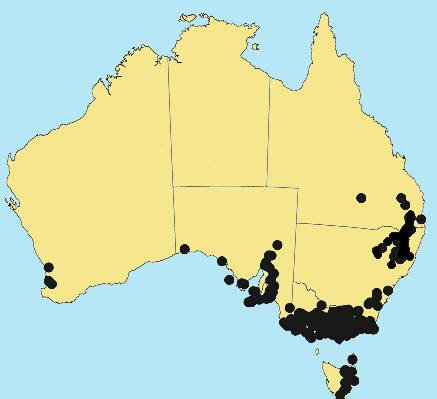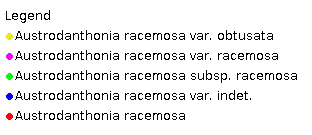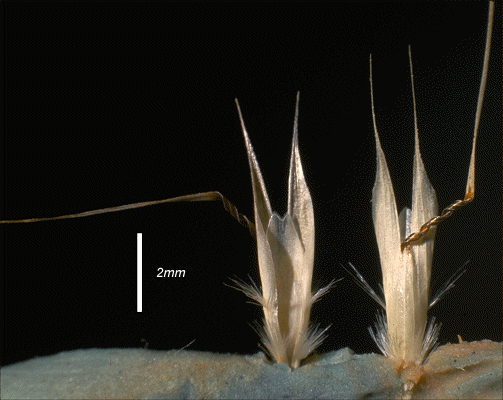Rytidosperma racemosum (R.Br.) H.P.
Linder. New Zealand J. Bot., 17(3): 327 (1979).
Classification. (GPWG 2001) : Subfamily Danthonioideae. Tribe
Danthonieae.
Basionym and/or
Replacement Name: Danthonia
racemosa R. Br., Prodr. 177 (1810).
Type of Basionym or
Protologue Information: HT: Brown 6235, Autralia: New South Wales:
Port Jackson (BM; IT: K(fragm., MEL, PERTH)).
Recent synonyms: Notodanthonia racemosa (R.Br.) Zotov, Danthonia racemosa R.Br.
var. obtusata F.Muell. ex Benth., Notodanthonia racemosa (R.Br.)
Zotov var. obtusata (F.Muell. ex Benth.) Veldkamp, Austrodanthonia
racemosa (R.Br.) H.P. Linder.
Key references
(books and floras): [1810]. R.Brown, Prodromus (177 as Danthonia
racemosa), [1878] G.Bentham, Flora Australiensis 7 (594 as Danthonia
racemosa), [2002] D.Sharp & B.K.Simon, AusGrass, Grasses of
Australia, [2006] J.Jessop, G.R.M.Dashorst, F.M.James, Grasses of South
Australia (295), [2008] S.W.L.Jacobs, R.D.B.Walley & D.J.B.Wheeler, Grasses
of New South Wales (146).
Illustrations:
[2005] K.Mallet (ed.), Flora of Australia 44B: Poaceae 3 (Fig.
11, E-Fas var. racemosa), [2006] J.Jessop, G.R.M.Dashorst, F.M.James, Grasses
of South Australia (295, fig. 231 as
var. racemosa), [1984] N.T.Burbidge. rev. S.W.L.Jacobs, Australian
Grasses (as D. racemosa).
Derivation: L.
racemus, stalk of a cluster of grapes; -osa, abundance. The
spikelets are borne in racemes or contracted panicles.
Habit.
Perennial. Culms erect, 16–60 cm tall, 3–4 -noded. Mid-culm nodes glabrous.
Leaf-sheaths glabrous on surface or hairy. Ligule a fringe of hairs, 0.25 mm
long. Leaf-blades involute, 5–15 cm long, 1–2 mm wide. Leaf-blade surface
scabrous, glabrous or indumented.
Inflorescence.
Inflorescence solid, a panicle. Panicle linear, 5–15 cm long.
Spikelets.
Spikelets pedicelled. Fertile spikelets many flowered, with at least 2 fertile
florets (4–10), comprising 4–10 fertile floret(s), with diminished florets at
the apex, cuneate, laterally compressed, 7.5–18 mm long.
Glumes. Glumes
similar, thinner than fertile lemma. Lower glume lanceolate, membranous, much
thinner on margins, without keels, 5–7 -nerved. Upper glume lanceolate, 7–16 mm
long, membranous, without keels, 5–7 -nerved. Upper glume surface asperulous.
Florets.
Fertile lemma 2–3.5 mm long, without keel, 9 -nerved. Lemma apex lobed, awned,
1 -awned or 3 -awned. Median (principal) awn from a sinus, 14 mm long overall,
with a twisted column. Column 4 mm long. Lateral lemma awns absent or present.
Lodicules present. Anthers 3. Grain 1.6–2.5 mm long.
Continental
Distribution: Australasia.
Australian
Distribution: Western Australia, South Australia, Queensland, New South
Wales, Victoria, Tasmania.
Western Australia:
Drummond, Dale, Menzies, Warren. South Australia: Flinders Ranges, Eyre
Peninsula, Northern Lofty, Murray, Southern Lofty, Kangaroo Island,
South-eastern. Queensland: Darling Downs, Moreton, Warrego. New South
Wales: North Coast, Central Coast, South Coast, Northern Tablelands,
Central Tablelands, Southern Tablelands, North-Western Slopes, Central-Western
Slopes, South-Western Slopes. Victoria: East Gippsland, Eastern
Highlands, Gippsland Highlands, Gippsland Plain, Grampians, Midlands, Otway
Plain, Otway Range, Wilsons Promontory, Riverina, Snowfields, Volcanic Plain,
Wannon, Wimmera. Tasmania: Furneaux Group, North East, Midlands, Ben
Lomond, East Coast, South West.
Notes. This
species shares with R. penicillatum linear inflorescences and
extravaginal innovations. It can be distinguished from R. penicillatum
by the glumes as long as or shorter than the flowers, by the shorter callus
hairs, and longer and more slender callus; however, some collections from the
Victorian coast are difficult to determine with confidence.
Widespread in
south-eastern Australia, from Rockhampton to Adelaide and Tasmania, altitude
0–1600 m, common on disturbed habitats, where it can be locally common, usually
in lightly shaded habitats, often found under trees, occasionally in full sun.
Flowers Oct. to Dec.
Infra-specific
taxa: var. racemosum, var. obtusatum .
Lateral lobes with
setae R. racemosum var. racemosum
Lateral lobes with
short points R. racemosum var. obtusatum








